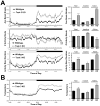TASK-3 as a potential antidepressant target
- PMID: 21885038
- PMCID: PMC3179828
- DOI: 10.1016/j.brainres.2011.08.021
TASK-3 as a potential antidepressant target
Abstract
Modulation of TASK-3 (Kcnk9) potassium channels affect neurotransmitter release in thalamocortical centers and other sleep-related nuclei having the capacity to regulate arousal cycles and REM sleep changes associated with mood disorders and antidepressant action. Circumstantial evidence from this and previous studies suggest the potential for TASK-3 to be a novel antidepressant therapeutic target; TASK-3 knock-out mice display augmented circadian amplitude and exhibit sleep architecture characterized by suppressed REM activity. Detailed analysis of locomotor activity indicates that the amplitudes of activity bout duration and bout number are augmented in TASK-3 mutants well beyond that seen in wildtypes, findings substantiated by amplitude increases in body temperature and EEG recordings of sleep stage bouts. Polysomnographic analysis of TASK-3 mutants reveals increases in nocturnal active wake and suppressed REM sleep time while increased slow wave sleep typifies the inactive phase, findings that have implications for the cognitive impact of reduced TASK-3 activity. In direct measures of their resistance to despair behavior, TASK-3 knock-outs displayed significant decreases in immobility relative to wildtype controls in both tail suspension and forced swim tests. Treatment of wildtype animals with the antidepressant Fluoxetine markedly reduced REM sleep, while leaving active wake and slow wave sleep relatively intact. Remarkably, these effects were absent in TASK-3 mutants indicating that TASK-3 is either directly involved in the mechanism of this drug's action, or participates in parallel pathways that achieve the same effect. Together, these results support the TASK-3 channel to act as a therapeutic target for antidepressant action.
Copyright © 2011. Published by Elsevier B.V.
Figures





Similar articles
-
Antidepressants with different mechanisms of action show different chronopharmacological profiles in the tail suspension test in mice.Chronobiol Int. 2019 Sep;36(9):1194-1207. doi: 10.1080/07420528.2019.1625360. Epub 2019 Jun 14. Chronobiol Int. 2019. PMID: 31198056
-
Orexin neurons are necessary for the circadian control of REM sleep.Sleep. 2009 Sep;32(9):1127-34. doi: 10.1093/sleep/32.9.1127. Sleep. 2009. PMID: 19750917 Free PMC article.
-
Behavior-dependent modulation of hippocampal EEG activity by the selective norepinephrine reuptake inhibitor reboxetine in rats.Hippocampus. 2007;17(8):627-33. doi: 10.1002/hipo.20299. Hippocampus. 2007. PMID: 17492692
-
[Biological models of depression: effect of antidepressants on sleep].Encephale. 1995 Dec;21 Spec No 7:35-40. Encephale. 1995. PMID: 8929677 Review. French.
-
Neural Circuitry of Wakefulness and Sleep.Neuron. 2017 Feb 22;93(4):747-765. doi: 10.1016/j.neuron.2017.01.014. Neuron. 2017. PMID: 28231463 Free PMC article. Review.
Cited by
-
Development of Non-opioid Analgesics Targeting Two-pore Domain Potassium Channels.Curr Neuropharmacol. 2022;20(1):16-26. doi: 10.2174/1570159X19666210407152528. Curr Neuropharmacol. 2022. PMID: 33827408 Free PMC article. Review.
-
Contribution of Neuronal and Glial Two-Pore-Domain Potassium Channels in Health and Neurological Disorders.Neural Plast. 2021 Aug 12;2021:8643129. doi: 10.1155/2021/8643129. eCollection 2021. Neural Plast. 2021. PMID: 34434230 Free PMC article. Review.
-
The family of K2P channels: salient structural and functional properties.J Physiol. 2015 Jun 15;593(12):2587-603. doi: 10.1113/jphysiol.2014.287268. Epub 2015 Jan 22. J Physiol. 2015. PMID: 25530075 Free PMC article. Review.
-
A Novel Relationship for Schizophrenia, Bipolar, and Major Depressive Disorder. Part 8: a Hint from Chromosome 8 High Density Association Screen.Mol Neurobiol. 2017 Oct;54(8):5868-5882. doi: 10.1007/s12035-016-0102-1. Epub 2016 Sep 22. Mol Neurobiol. 2017. PMID: 27660274
-
Gain and loss of TASK3 channel function and its regulation by novel variation cause KCNK9 imprinting syndrome.Genome Med. 2022 Jun 13;14(1):62. doi: 10.1186/s13073-022-01064-4. Genome Med. 2022. PMID: 35698242 Free PMC article.
References
-
- Angles-Pujolras M, Diez-Noguera A, Soria V, Urretavizcaya M, Menchon JM, Cambras T. Electroconvulsive shock alters the rat overt rhythms of motor activity and temperature without altering the circadian pacemaker. Behav Brain Res. 2009;196:37–43. - PubMed
-
- Barel O, Shalev SA, Ofir R, Cohen A, Zlotogora J, Shorer Z, Mazor G, Finer G, Khateeb S, Zilberberg N, Birk OS. Maternally inherited Birk Barel mental retardation dysmorphism syndrome caused by a mutation in the genomically imprinted potassium channel KCNK9. Am J Hum Genet. 2008;83:193–199. - PMC - PubMed
-
- Bayliss DA, Talley EM, Sirois JE, Lei Q. TASK-1 is a highly modulated pH-sensitive ‘leak’ K(+) channel expressed in brainstem respiratory neurons. Respir Physiol. 2001;129:159–174. - PubMed
-
- Borbely AA, Tobler I, Loepfe M, Kupfer DJ, Ulrich RF, Grochocinski V, Doman J, Matthews G. All-night spectral analysis of the sleep EEG in untreated depressives and normal controls. Psychiatry Res. 1984;12:27–33. - PubMed
Publication types
MeSH terms
Substances
Grants and funding
LinkOut - more resources
Full Text Sources
Other Literature Sources
Molecular Biology Databases

